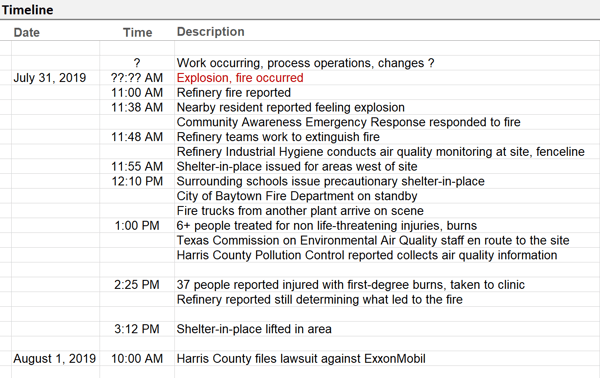In the event of an incident, the first priority is the safety of people. When an explosion occurred at an Exxon Mobil refinery in Baytown, Texas on Wednesday, July 31, 2019, around 11 a.m., emergency and crisis management plans were put into action, but the first priority was the safety of those in and around the area.
Thirty-seven people were injured and taken to an offsite medical clinic with first-degree burns, and a shelter in place was ordered for nearby residents while environmental regulatory personnel monitored the air quality in and around the site. While safety is the priority, additional efforts went toward containing the crisis, so it didn’t get worse or further affect the organization’s operations, assets and property.
Once those two priorities are under control, organizations can begin to collect and organize information for a thorough investigation into what happened and how it can be avoided in the future. An incident of this magnitude requires a lot of information to be collected for an investigation. There are two main ways to organize the information: chronology (also known as a timeline) and cause-and-effect analysis.
The sequence of events leading up to the incident are important to capture. With limited information immediately available after the event, we started a basic timeline of events. Currently, we don't have that information, so it's noted on the timeline as "work occurring, process operations, changes" with a question mark. Conversations with those knowledgeable about the unit operations and the process data will provide the necessary information to build a much more detailed timeline. This basic timeline below shows some of what happened once the incident occurred. It's simple, but that's how all timelines begin. Detail will be added as information becomes available. See our timeline so far:

Although the timeline is helpful to capture the order in which events occurred, cause and effect explains why the incident happened to provide solutions for minimizing the risk of it occurring again in the future. A Cause Map™ can begin basic and then expand as needed. It starts with any affected goal, and then backs into the causes by asking Why questions. At the onset of an investigation, the information may be limited, so the analysis is still in early stages. Here, we show information in a basic 3-Why Cause Map™:
 Right now, this map includes question marks, which indicate we’re missing important details. These question marks act as action items for us to add information as it becomes available. As more information is collected through the investigation, this Cause Map™ will become more detailed to include the additional information and supporting evidence. As the analysis expands, we’ll share the updated versions with you on our blog.
Right now, this map includes question marks, which indicate we’re missing important details. These question marks act as action items for us to add information as it becomes available. As more information is collected through the investigation, this Cause Map™ will become more detailed to include the additional information and supporting evidence. As the analysis expands, we’ll share the updated versions with you on our blog.In this case, the shelter-in-place order was lifted a few hours after being issued since air toxins weren’t detected, but this refinery’s incident will continue to impact the company, its employees and nearby residents. Of course, no one wants an incident like this to occur, but it’s important that organizations have a crisis management plan in place to mitigate risk to personnel and community, respond swiftly and appropriately, coordinate activities, communicate effectively and conduct a thorough investigation.










